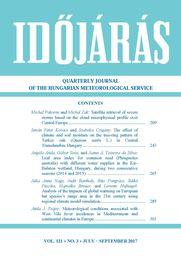IDŐJÁRÁS - angol nyelvű folyóirat
Vol. 121, No. 3 * Pages 209–328 * July - September 2017
 |
|
 letöltés [pdf: 5004 KB]
letöltés [pdf: 5004 KB]
Satellite retrieval of severe storms based on the cloud microphysical profile over Central Europe
Michal Pokorny and Michal Zak
idojaras.2017.3.1 (p. 209–)
Michal Pokorny and Michal Zak
idojaras.2017.3.1 (p. 209–)
The effect of climate and soil moisture on the tree-ring pattern of Turkey oak (Quercus cerris L.) in Central Transdanubia, Hungary
István Péter Kovács and Szabolcs Czigány
idojaras.2017.3.2 (p. 243–)
István Péter Kovács and Szabolcs Czigány
idojaras.2017.3.2 (p. 243–)
Leaf area index for common reed (Phragmites australis) with different water supplies in the Kis-Balaton wetland, Hungary, during two consecutive seasons (2014 and 2015)
Angéla Anda, Gábor Soós, and Jaime A. Teixeira da Silva
idojaras.2017.3.3 (p. 265–)
Angéla Anda, Gábor Soós, and Jaime A. Teixeira da Silva
idojaras.2017.3.3 (p. 265–)
Analysis of the impacts of global warming on European bat species’s range area in the 21st century using regional climate model simulation
Júlia Anna Nagy, Judit Bartholy, Rita Pongrácz, Ildikó Pieczka, Hajnalka Breuer, and Levente Hufnagel
idojaras.2017.3.4 (p. 285–)
Júlia Anna Nagy, Judit Bartholy, Rita Pongrácz, Ildikó Pieczka, Hajnalka Breuer, and Levente Hufnagel
idojaras.2017.3.4 (p. 285–)
Meteorological conditions associated with West Nile fever incidences in Mediterranean and continental climates in Europe
Attila J. Trájer
idojaras.2017.3.5 (p. 303–)
Attila J. Trájer
idojaras.2017.3.5 (p. 303–)
IDŐJÁRÁS folyóirat

Az IDŐJÁRÁS a HungaroMet Nonprofit Zrt. negyedévenként megjelenő angol nyelvű folyóirata
Megrendelhető a journal.idojaras@met.hu címen.
A szerzőknek szánt útmutató itt olvasható.
Megrendelhető a journal.idojaras@met.hu címen.
A szerzőknek szánt útmutató itt olvasható.









